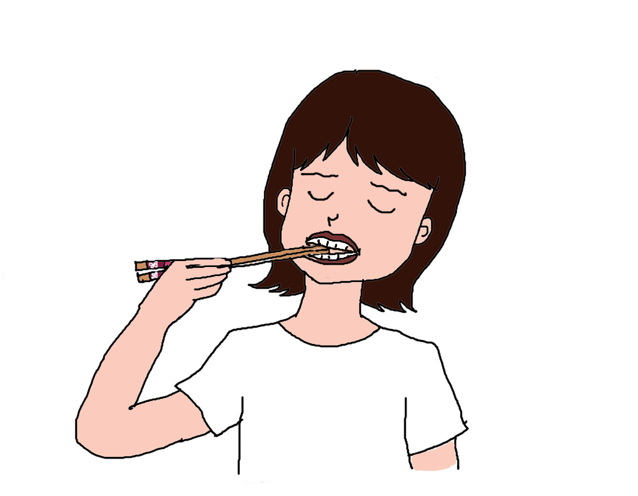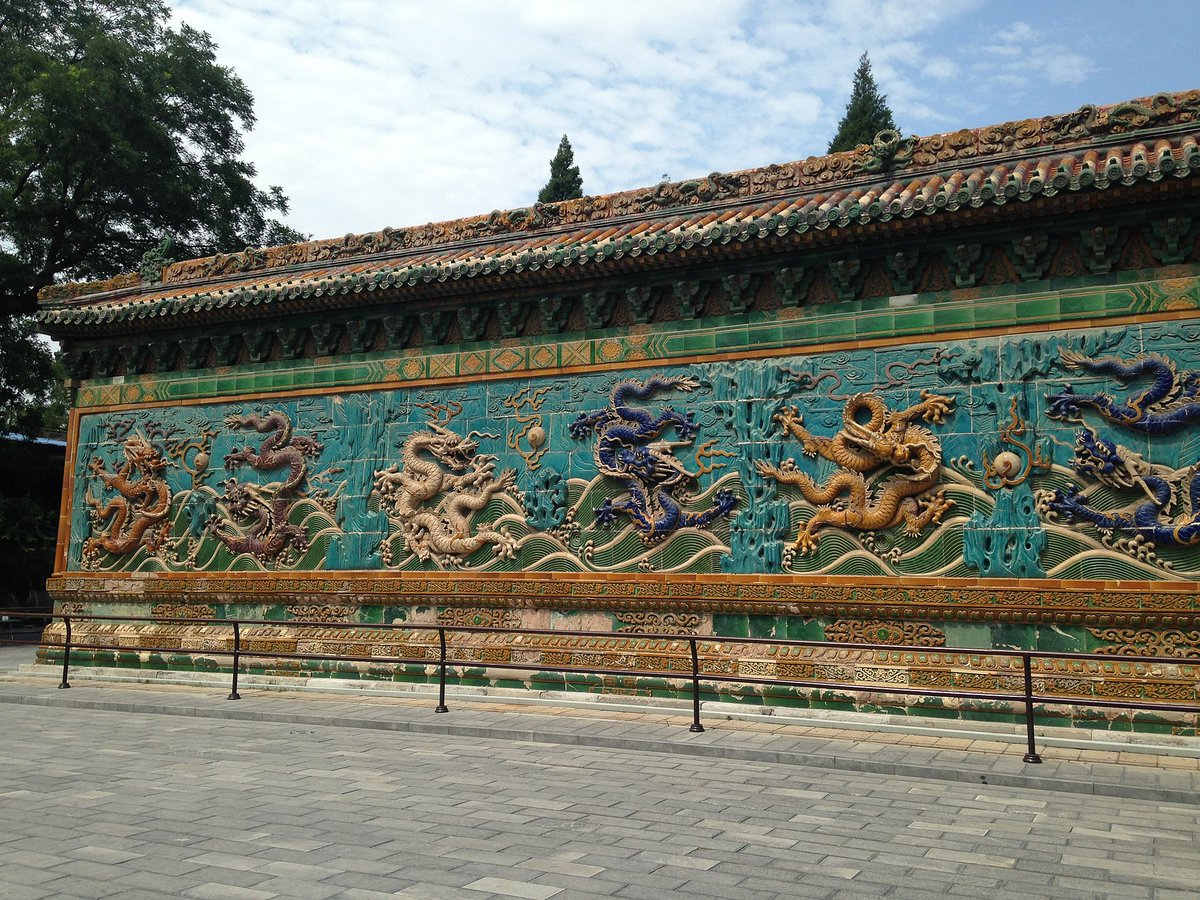Japanese terms for rude things to do with your chopsticks!
If it's something rude you can do with a pair of chopsticks, Japanese has a special term for it.
A thread...
If it's something rude you can do with a pair of chopsticks, Japanese has a special term for it.
A thread...

1. Hashiwatashi 箸渡し ("chopstick passing")
Don't pass food directly from your chopsticks to another person's chopsticks.
Don't pass food directly from your chopsticks to another person's chopsticks.

2. Tsukitatebashi 突き立て箸 ("piercing standing chopsticks"), or just tatebashi 立て箸 ("standing chopsticks") for short
Don't stab your chopsticks into your bowl of rice so they stand upright (this is done for Buddhist funerary offerings, so doing it otherwise is very rude).
Don't stab your chopsticks into your bowl of rice so they stand upright (this is done for Buddhist funerary offerings, so doing it otherwise is very rude).

3. Tontonbashi, トントン箸 ("tap-tap chopsticks")
Don't tap your chopsticks on your plate to make them line up with each other, which makes a sound like "ton ton." Instead, slide them with your fingers.
Don't tap your chopsticks on your plate to make them line up with each other, which makes a sound like "ton ton." Instead, slide them with your fingers.
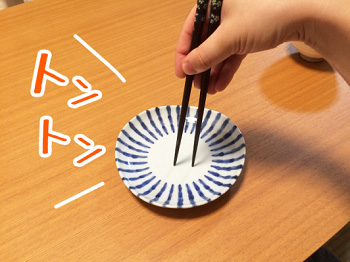
4. Kakibashi 掻き箸 ("shoveling chopsticks")
Don't hold your bowl up to your face and use your chopsticks to rapidly shovel food into your mouth.
Don't hold your bowl up to your face and use your chopsticks to rapidly shovel food into your mouth.

5. Kuwaebashi 咥え箸 ("holding-in-mouth chopsticks")
Never let your chopsticks dangle from your mouth or close your mouth around the ends of chopsticks for even a moment longer than is absolutely necessary to eat.
Never let your chopsticks dangle from your mouth or close your mouth around the ends of chopsticks for even a moment longer than is absolutely necessary to eat.
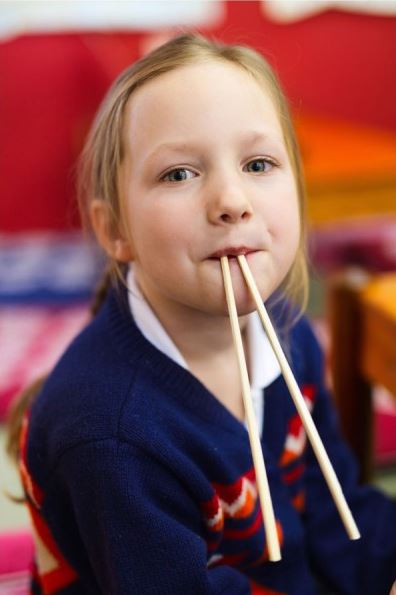
6. Mayoibashi, 迷い箸 ("indecisive chopsticks")
Don't wave your chopsticks around in the air above the different dishes on the table, as if wondering what to eat next.
Don't wave your chopsticks around in the air above the different dishes on the table, as if wondering what to eat next.
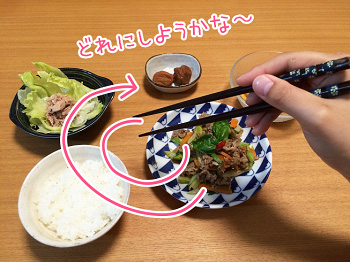
7. Tatakibashi 叩き箸 ("drumming chopsticks")
Don't use your chopsticks like drumsticks on the edge of your bowl (whether to get people's attention or simply to make a nice rhythm).
Don't use your chopsticks like drumsticks on the edge of your bowl (whether to get people's attention or simply to make a nice rhythm).
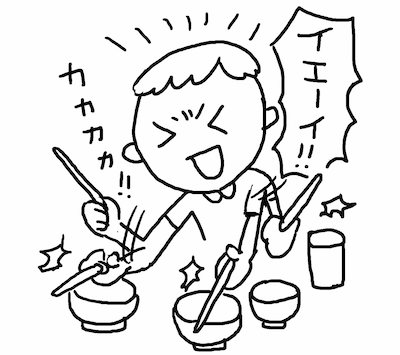
8. Watashibashi 渡し箸 ("bridging chopsticks")
Never rest your chopsticks across the top of your bowl like a bridge (confession: I do this one all the time).
Never rest your chopsticks across the top of your bowl like a bridge (confession: I do this one all the time).
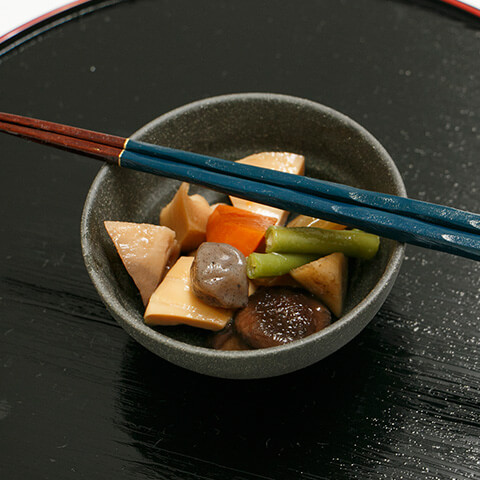
9. Neburibashi 舐り箸 ("licking chopsticks")
Never lick the ends of your chopsticks.
Never lick the ends of your chopsticks.
10. Yosebashi 寄せ箸 ("drawing-near chopsticks")
Never use your chopsticks to pull a bowl or plate closer to yourself.
Never use your chopsticks to pull a bowl or plate closer to yourself.

11. Saguribashi 探り箸 ("searching chopsticks")
Don't stir your chopsticks around in a dish, looking for a certain ingredient you want to eat.
Don't stir your chopsticks around in a dish, looking for a certain ingredient you want to eat.

12. Komibashi 込み箸 ("stuffing chopsticks")
Never use your chopsticks to stuff an already full mouth with even more food.
Never use your chopsticks to stuff an already full mouth with even more food.

13. Sashibashi 刺し箸 ("stabbing chopsticks")
Never use your chopsticks to stab food the way you would with a fork.
Never use your chopsticks to stab food the way you would with a fork.

14. Sashibashi 指し箸 ("pointing chopsticks")
Never use your chopsticks to point at another person.
Somewhat confusingly, it sounds the same as the stabbing one above, but uses a different kanji.
Never use your chopsticks to point at another person.
Somewhat confusingly, it sounds the same as the stabbing one above, but uses a different kanji.

16. Yokobashi 横箸 ("adjacent chopsticks")
Don't hold your chopsticks side-by-side and use them like a spoon.
Don't hold your chopsticks side-by-side and use them like a spoon.
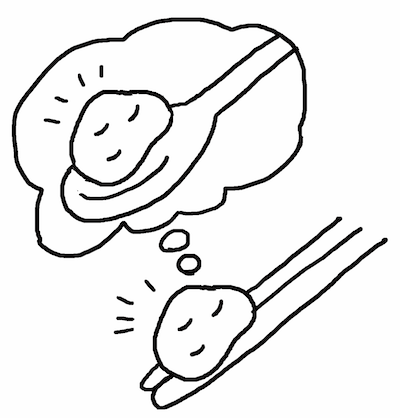
17. Namidabashi 涙箸 ("crying chopsticks")
Don't wave your wet chopsticks around so they drip soup all over.
Don't wave your wet chopsticks around so they drip soup all over.

18. Utsuribashi, 移り箸 ("shifting chopsticks")
Don't eat one dish with chopsticks and then eat a different dish without eating rice in between.
(You are supposed to eat at least one bite of rice before you eat a different dish. I don't understand why this is a thing).
Don't eat one dish with chopsticks and then eat a different dish without eating rice in between.
(You are supposed to eat at least one bite of rice before you eat a different dish. I don't understand why this is a thing).

19. Hanebashi 撥ね箸 ("excluding chopsticks")
Don't use your chopsticks to pick out all of one ingredient you don't like.
In Japan, for some strange reason, carrots are the stereotypical vegetable kids hate (like spinach is elsewhere), hence carrots are excluded in this pic.
Don't use your chopsticks to pick out all of one ingredient you don't like.
In Japan, for some strange reason, carrots are the stereotypical vegetable kids hate (like spinach is elsewhere), hence carrots are excluded in this pic.

20. Mochibashi 持ち箸 ("held chopsticks")
Don't grab a bowl or a glass while holding chopsticks in the same hand.
Don't grab a bowl or a glass while holding chopsticks in the same hand.
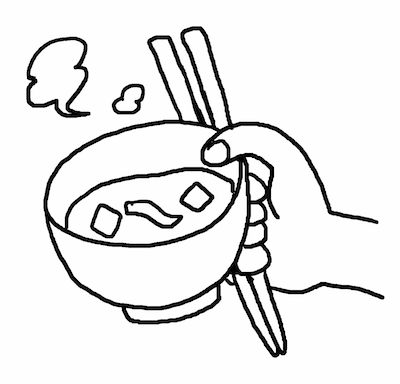
21. Mogibashi もぎ箸 ("plucking chopsticks")
Don't suck off the rice grains that are stuck to the ends of your chopsticks.
Don't suck off the rice grains that are stuck to the ends of your chopsticks.
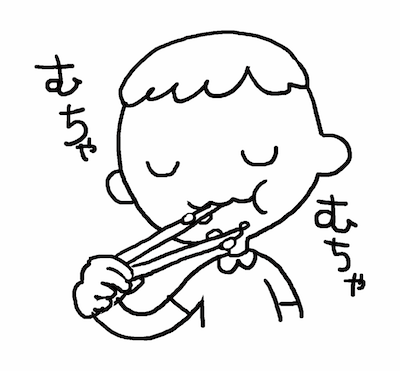
22. Araibashi 洗い箸 ("washing chopsticks")
Don't rinse off your chopsticks in your soup or in your drink.
Don't rinse off your chopsticks in your soup or in your drink.
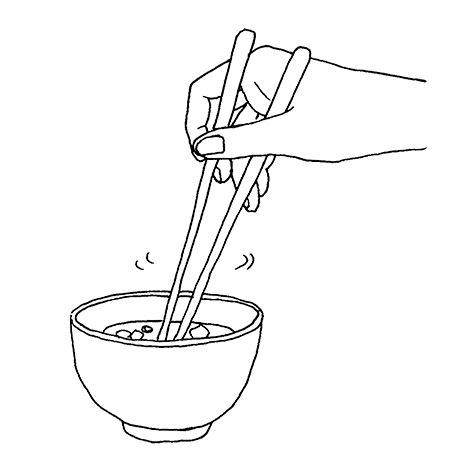
23. Kasanebashi 重ね箸 ("over-and-over chopsticks")
Don't keep eating one dish over-and-over while ignoring the other dishes.
Don't keep eating one dish over-and-over while ignoring the other dishes.
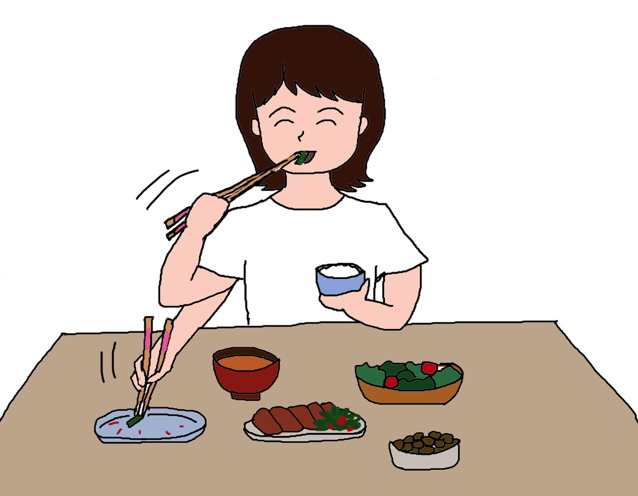
24. Sorabashi 空箸 ("dishonest chopsticks")
Don't touch a piece of food with your chopsticks but then not eat it.
If you touch something edible with your chopsticks, you MUST put it in your mouth IMMEDIATELY.
Don't touch a piece of food with your chopsticks but then not eat it.
If you touch something edible with your chopsticks, you MUST put it in your mouth IMMEDIATELY.
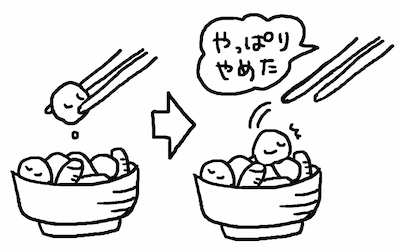
25. Sukashibashi すかし箸 ("poking through chopsticks")
After eating the top half of a fish, don't eat the bottom half by poking through the bones (you are supposed to flip it over to eat the other side).
After eating the top half of a fish, don't eat the bottom half by poking through the bones (you are supposed to flip it over to eat the other side).
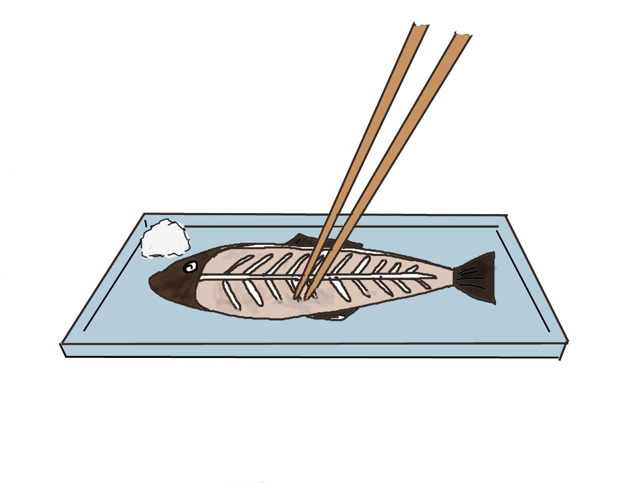
26. Jikabashi 直箸 ("direct chopsticks")
This refers to using your own personal chopsticks to take food directly from the serving dish instead of using serving chopsticks or another serving implement.
This refers to using your own personal chopsticks to take food directly from the serving dish instead of using serving chopsticks or another serving implement.

27. Chigiribashi 千切り箸 ("tear-to-shreds chopsticks")
Don't hold each chopstick in a different hand and use them to tear your food apart.
Don't hold each chopstick in a different hand and use them to tear your food apart.
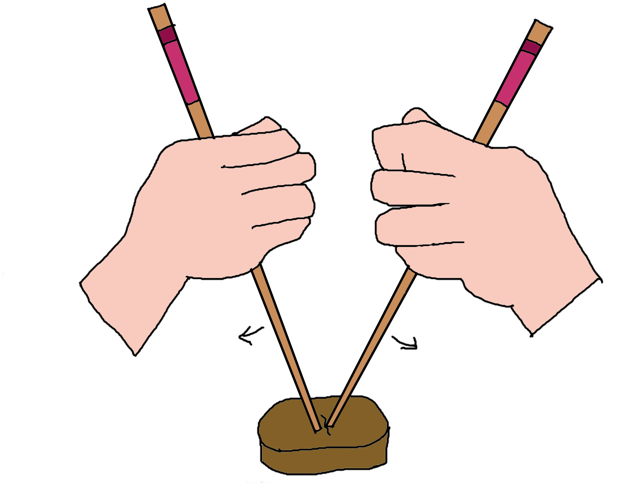
28. Futaribashi 二人箸 ("two people chopsticks")
Two people should never touch the same piece of food with their chopsticks at the same time (people are tempted to do this in order to split a food item in half).
Two people should never touch the same piece of food with their chopsticks at the same time (people are tempted to do this in order to split a food item in half).
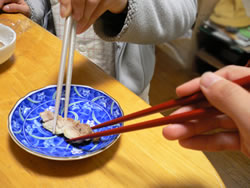
29. Furibashi 振り箸 ("shaking chopsticks")
Don't wave your chopsticks around in the air to shake off soup.
Don't wave your chopsticks around in the air to shake off soup.
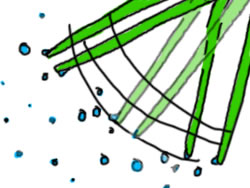
32. Chigaibashi 違い箸 ("mismatched chopsticks")
Don't use mismatched chopsticks.
In particular, never use two chopsticks where one is made out of wood and one made out of bamboo, because one bamboo chopstick and one wood chopstick are used to pick up remains after cremation.
Don't use mismatched chopsticks.
In particular, never use two chopsticks where one is made out of wood and one made out of bamboo, because one bamboo chopstick and one wood chopstick are used to pick up remains after cremation.
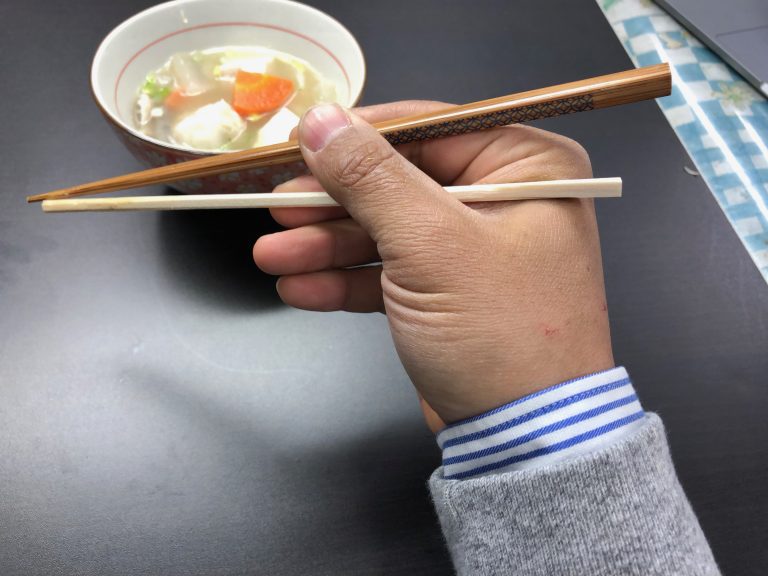
33. Furiagebashi 振り上げ箸 ("raising-up chopsticks")
Never allow the tips of your chopsticks to rise above the level of the back of your hand at any time.
Never allow the tips of your chopsticks to rise above the level of the back of your hand at any time.

34. Ogamibashi 拝み箸 ("praying chopsticks")
Never grasp your chopsticks between your thumbs and index fingers and put your hands together like you are praying.
(Japanese put hands together and say "itadakimasu" before each meal, and some try to do this with chopsticks in hand)
Never grasp your chopsticks between your thumbs and index fingers and put your hands together like you are praying.
(Japanese put hands together and say "itadakimasu" before each meal, and some try to do this with chopsticks in hand)

35. Zengoshi 膳越し ("across the table")
Never reach across with chopsticks to take food from a dish on the other side of the table.
Instead, pick up the dish with your hands and bring it closer to you, or ask someone else to pass it to you.
Never reach across with chopsticks to take food from a dish on the other side of the table.
Instead, pick up the dish with your hands and bring it closer to you, or ask someone else to pass it to you.
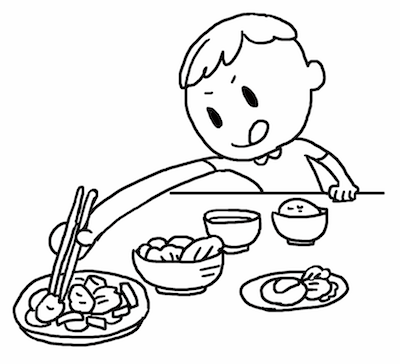
36. Ukebashi 受け箸 ("receiving chopsticks")
Never ask for more food while you are still holding your chopsticks in your hand.
Never ask for more food while you are still holding your chopsticks in your hand.
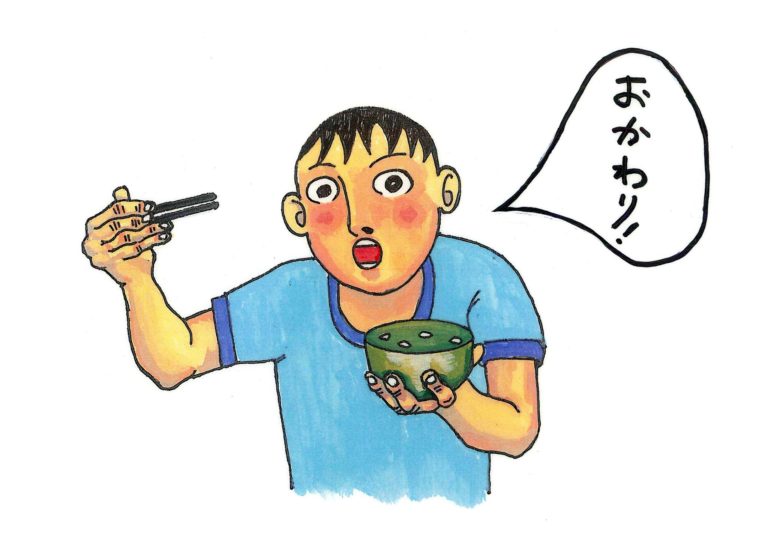
37. Kaeshibashi 返し箸 ("reverse chopsticks") aka Sakasabashi 逆さ箸 ("upside-down chopsticks")
Don't use the opposite ends of your chopsticks to serve yourself from a communal dish.
Chopstick noobs think this is cool way to avoid spreading germs, but it's actually just gross.
Don't use the opposite ends of your chopsticks to serve yourself from a communal dish.
Chopstick noobs think this is cool way to avoid spreading germs, but it's actually just gross.

38. Kakibashi 掻き箸 ("scratching chopsticks")
Don't use your chopsticks to scratch your head.
(This one uses the same characters as number 4, above)
Don't use your chopsticks to scratch your head.
(This one uses the same characters as number 4, above)

39. Kosuribashi 擦り箸 ("rubbing chopsticks")
Don't rub your chopsticks against each other.
In particular, don't rub newly separated disposable wooden chopsticks together to remove splinters.
Don't rub your chopsticks against each other.
In particular, don't rub newly separated disposable wooden chopsticks together to remove splinters.

40. Hidaribashi 左箸 ("left chopsticks")
Never hold your chopsticks in your left hand at any time.
This one was discriminatory toward left-handed people. In the past, lefties were forced to use chopsticks right-handed, but fortunately this "rule" has mostly gone away nowadays.
Never hold your chopsticks in your left hand at any time.
This one was discriminatory toward left-handed people. In the past, lefties were forced to use chopsticks right-handed, but fortunately this "rule" has mostly gone away nowadays.

41. Kо̄sabashi 交差箸 ("crossing chopsticks")
Do not allow your chopsticks to cross each other, either on your plate or in your hand.

Do not allow your chopsticks to cross each other, either on your plate or in your hand.

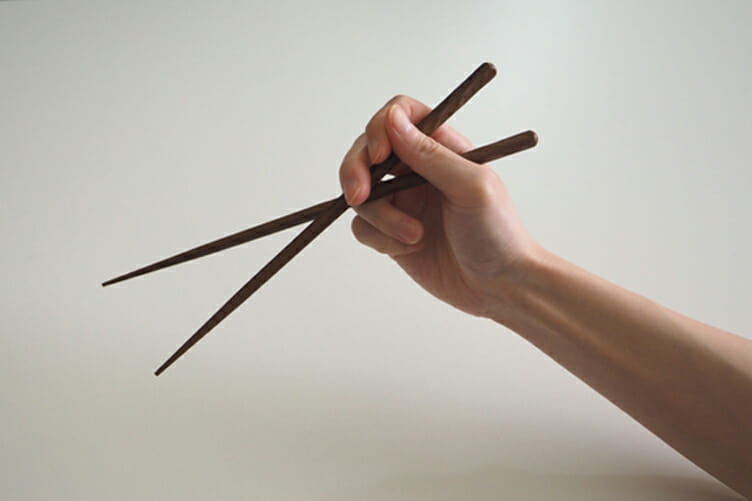
• • •
Missing some Tweet in this thread? You can try to
force a refresh



